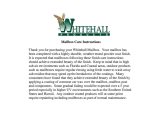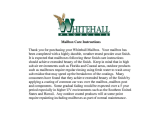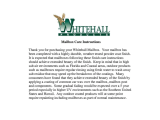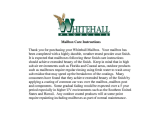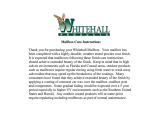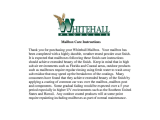Page is loading ...


Toshiba VP Systems Configwation Manual
Table
of
Contents
Chapter 1 Understanding Configuration
#-
1.1
12
1.3
1.4
1.5
1.6
I.7
uw~~ticnl
..........................................................
l-l
Fbsachin~ Uw Toshiba VP System
.......................................................
l-2
-%m
....................................................................
l-3
(Jonventi#s FCC EnterlnQ I-
............. ..- ....................................
l-5
DesuiptimOf W~uratiTW
.....................................................
l-7
lntemlatimshipAmmQT~
....... ..-........................................-.....l- 8
Using the bnfiguratim Package
......................................................
l-12
21 Uming INSTALL ..............................................................
2-l
22 Using INSTALL .....................................................................
2-4
2.3 QwstimsFwOtbrPhOneSyshmS
...................................................
2-18
24 INSTALL Exiing Befme hstaif is cb?-~ptete
.............................................
2-19
3.1
Udestanding UPDAlE
. . . ..-.---.....-...........~.‘.................................
3-l
32 Using UPDATE . . . . . . . . . . . . . . ..-............................*.......................
3-3
Chapter 2 Install
Chapter 3 Update
Chapter 4 Bus Information Table.
.,
-l?w BUS INFORMATION Tabk ..--.....................................~..............
4-l
Chapter 5 COS Table
5.1
~
Ur&&anding Class Of Senfii (COS)
. . . . . . . ..-........................................
5-l
52 HowtheCOST~leisUsed . . . . . . . . . . . . . . . . ...-.......................................5-2
5.3 What Attributes Are . . . . . . . . . . . ..-....................................................
5-3
5.4 HowtoCcdguretheCOSTabIe ---
. . . . . . ..-........-.-..-............................
5-26
6.1
62
6.3
6.4
Chapter
6
CSTAT Table
LJc&standing the CSTAT Tat&
----...-...-.-........-................................
6-l
PDLlndexVaba -...-...-....---..---....-...-.-......---.-.......-......~........-.6-2
~~~TATT~leisU~~~PDL~xVal~ . . . . . . . . . . . . . . . . . . . . . . . . ..-.......... 6-3
HOW to Cmfigure the CSTAT Table br the PDL lrxdex Value
. . ..e...............-........... 6-4
(mntinmci)

Table of Contents
(continued)
j . . .
7.1
7.2
7.3
8.1
8.2
- -8.3
9.1
9.2
9.3
10.1 Udrstanding~DTMFlNTTable
....................................................
10-l
10.2 HowtoCmfiguretheDTMFlNTTable
..................................................
10-5
10.3 ISTY Checking During Cmfigmation
................................................... 1~
7
11.1 Umhstanding the FlR.STDlGlT Table
..................................................
11-l
112 How the FRSTDlGrT Tab18 is Used
.................................................... ll-
2
11.3 HowtoCmfiguretheFRSlDiGITTable
................................................
11-3
12.1
12.2
12.3
13.1
13.2
13.3
14.1
14.2
Chapter 7 Custom Prompt Table
Uming the CUSOM PROMPTTable .*-
How tha CUSTOM PROMPT Table WC&S
.............................................
7-l
................................................
7-3
How to Ccdgure the CUSTOM PROMPTTW
...........................................
7-4
Chapter 8 Daylight.Saving Time Table
lJnde&anding the DAYLIGHT SAVING TIME Table
........................................
8-l
How the DAYLIGHT SAVING TIME Table is Usad
........................ ..-...............8- 2
HowtoCcnfiguretheDAYUGHT~VlNGTiMETable
......................................
8-3
Chapter 9 Distribution List Table
U&standing the DETlWUTlON LIST Table
............................................
9-l
How tha DISTRIBUTION LISTTable is Used
..............................................
9-2
How to Configure Distributicn Lists and Extended Mailboxes
................................
Chapter 10 DTMFINT Table
Chapter 11
FirstDigit Table
.,
Chapter 12 Holiday Table
lJnd6mardi~ the HOLIDAY Table
.................................................. ..12- 1
Hc+,vtheHOLlDAYTableisUsad .......................
...............................
12-2
How to Configure the HOLIDAY Table
.............................. ..-...........-.....12- 3
Chapter 13 Information Table
Un&standing INFORMATION Tables
.........................
.........................
13-l
How INFORMATION Tablas are Used
..................................................
13-4
Ho,v to Cmfigufe INFORMATlON Tables
...............................................
13-5
Chapter
14
Location Table
IJXATlON Table fw Mutti-Cab;net Netwoking
..........................................
14-l
KXATION Table for Remote Netwmking
............................................... 14-5
(continued)

Table of Contents
(continued)
section Descdcdon
Pam
Chapter 15 Names Table
15.1
W&standing the NAh4ES Table
......................................................
15-l
152
liowtheNAMEST~isUsed
...................................................... ..15- 2
15.3
HOWtOOXlfi~~NAMEST~
....................................................
15-3
Chapter 16 Numbering Plan Table
16.1 NUMBERING Pun TW fcx Multi-Cabinet Netwcxkirg
..a
. . . . . . . . . . . . . . . . . . . . . . . . . . . . . . . . . . .
16-l
l62 -.
NUMBERING PIAN Tabk fu Remote Networkii
. . . . . . . . . . . . . . . . . . . . . . . . . . . . . . . . . . . . . . . .
16-4
.-
Chapter 17 Ports Table
17.1
Un&standing W PORTSTale
................................................... ...17- 1
172
How the PORTS Table is Used
...................................................... ..17- 2
17.3
HowtoContigurethePORTST~le
.................................................... 17-4
18.1 PREFlXDiGilST&le . . . . . . . . . . . . . . . . . . . . . . . . . . . . . . . . . . . . . . . . . . . . . . . . . . . . . . . . . . . . ...18-1
18.2
WtoConfigure~PREFlXDlGlTSTable . . . . . . . . . . . . . . . . . . . . . . . . . . . . . . . y . . . . . . . . . . . . . 18-2
19.1
19.2
20.1 .
20.2
20.3
21.1
U~i~~SLOTSTable ......................... ..-..................-.......21- 1
21.2
Howth8SLOTSTableisUsed ...
..-~..........~-..................................-~.21- 5
21.3
HowtoCcnfiguretheSLOTSTable
.................................................... 21-9
22.1
Urxjerstanding tha SYSTEM PARAMElER T&h
-..---........-........--.....~........-. Z-1
222
HowtheSYSTEMPAFWKrERTableisUsed . . . . . . . . . . . . . . . ..-......................... 22-5
22.3
HowtoConfiguretheSYSTEMPAFLAM~RTable .~.~ . . . . . . ..-...-..-....-.. ~ . . . . . . ~ . . . . 22-6
\
22.4
Description&SystemI%rametWs .-...--..........~..-.~..--......-...........~.......~-9
Chapter 18 Prefm Digits Table
Chapter 19 Route Table
ROLKETableforMutti-CabinetNetworking . . . . . . . . . . . . . . . . . . . . ...-..................-..19-1
ROLITE Table fcx Remote Networking . . . . . ..--.........................................
19-4
Chapter 20 Schedule Table
UnWstandi~theSCHEDULEtable..
................................ .
..................
sl
HowtheSCHEDULETablssare Used
.................................................. 20-2
How to Ccdigure the SCHEDULE Table
................................................
20-3
Chapter 21 Slots Table
Chapter 22 System Parameter Table

Table of
Contents
(cmtinuecf)
23.1
23.2
23.3
Chapter 23 Translation Table
I.k&ea&n~ the TFtANSlATlON TABLE
......... ..*...................-.-.~~.........~-,
How the TRANSlATlON T&b is Used .............................. ..-.......-.~......~- 2
How to bTfiQm the TRANSUTION Table
............................................. 23-3
Chapter 24 Trunk Group Table
24.1
Lhc%enSn~ the TRUNK GROUP Table
..................... .
.........................
24-l
.
-24.2 -
HowtbeTiunkGmpTable~Used
................................................... 24-2
24.3
H~to~~~T~Gr~pT~le...-......-.....................~-.-............24- 3
Chapter 25 User Table
25.1
b-de&xdn~ U-a USER Tale
......... ..-.-......-....--..............-...-..-......~- 1
25.2
HowtheUSERTa9IaisUsed ........... ..-....................-..-.........-.......-.~- 2
25.3
Hw~~CU%QIJ~I~~~USERT&I~ ..................................................... B-3
Index . . . . . . . . . . . ..--.............--...-....-..................----..-... ::I .-........~~. IM~A

Toshiba VP Systems
Configuration
Manual
Table of Contents - Figures
Chapter 1 Understand*ing Configuration
l
l-l Tablehtemala&nship!sforh4aibcues, PcfkandTfunks . . . . . . . . . . . . . . . . . . . . . . . . . . . ..-... . . . l-10
l-2 Ncfmal~lFlc4f . . . . . . . . . . . . . . . . . . . ..*.............................................l-ll
Chapter 2 install
-i-j -
O&rofQuest~andkscciat~TabksinthelNSTALLProgam . . . . . . . . . . . . . . . . . . . . . . . . . . . 2-3
5-l ~d~ii~xF~w~~~~.........................................5-4
5-2
Exarr@le of MaiIbx Function with CCS Attributes ..-.................................*....5-5
Chapter 5 COS Table

ToshibaVP Systems
Confjgurafion
Manual
Table of Contents - Tables
Table DeScriDtkm
Pa+
l-l
3-l
- ~
5-l
5-2
10-l
Chapter 1 Understanding Configuration
l
Twmird CWnmuntith ccmedms
. . . . . . . . . . . . . . . . . . . . . . . . . . . . . . . . . . . . . . . . . . . . . . . . . .
l-5
Chapter 3 Update
UPDATE,Ab&&atiom,VaIiiCom~andMcdii~ . . . . . . . . . . . . . . . . . . . . . . . . . . . . ..e...m 3-6
Chapter 5 COS Table
00s Atmutes . . . . . . ..-..............-...............-...............-.......-.-....
S-6
COSAtt&u&s
by Cam . . . . . . . . . . . . . . . . . . . . . . . . . . . . . . . . . . . . . . . . ..-..........-.....
5-6
Chapter 10 DTMFINT Table
iii@iy
fWpiredandOpticmlF~forCallFteaxdTyps . . . . . . . . . . . . . . . . . . . . . . . . . . . . . . . . . . . . . . . 10-4
ToshlbaVFSysmm Pc3kase5.3 MY.lWl

I-
-
Chapter Contents
UNDERSTANDING CONFIGURATION
1.1
1.2
1.3
1.4
1.5
1.6
1.7
U~i~~guration
.......................................................... l-
1
F&aching the Ttiiba VP System .......................................................
1-z
lksurhgmty
....................................................................
l-3
Maintenancs
....................................................................
l-3
~mini~tive......................-..........-...............................~.l- 3
~~...............--.-......................................................l- 4
Ccrwentiwts For Entering lnfcnnaticn
................................................... l-5
Entering hformaticn ............................................................. l-5
lksu-iptim Of Configuration Tables .....................................................
l-7
interrelaticnship Among T&k .... ..-..-..............................................l- 8
Evaluating the Digits Entered by the Cakr
........................................... l-8
C&ding the USER Table ......................................................... l-8
Checking the Class of Sefvice
.,
..................................................... l-9
Checking the SCHEDULE and INFORMATION Tables
.................................. l-9
U~~~~~gu~~~~~age-..........-..........................................l-l 2
Configuration Forms ............................................................ l-14
Figures and Tables
Fiaure
Descridlon
Paa?
l-l
Table Interrelationships for Mailboxes, Ports andTrunks.. . . . . . . . . . . . . . . . . . . . . . . . . . . . . . . . . . . l-10
l-2
N~~l~llFlow~......................................................~...........l-ll
.Table
DescriDtion PK?e
l-l
Tesminal Communicati&S Conventions. . . . . . . . -. . . . -. . . . . . . - -. . . . . . . . . . . . . . . . . . . . . . . . . . - l-5

INTRODUCTION
This chapter presents an overview of the configuration process, including conventions for entering
information via a directly
co~ected
or remote terminaI or teleprinter.
A
description of all
dition tables and their interrelationship follows. The section on system secu&y details
how to assure that only authorized people have access to the Tshiba VP System software.
AM included is a section on ampleting the configuration forms. Blank configuration forms for
your use are at the end of the chapter.

Quick Reference Guide
Understanding Con&uration
Descrlptton
- -
~ The Toshiba VP System
Operating System - Indicated by the @ prompt
Software
Controls
all real-time telephony fknctions as well as
diagnostics,
system
activity, and the 4kction and repxting of data.
INSTALL
Program - Indicated by the : prompt
In order to crate the ‘lbshiba VP System database, the program
asks a series of questions and then places the replies into the vari-
ous umfiguration tables.
UPDATE
Program - hxilcated by tie . prompt
Enables changes to database
em&s.
Reaching the Toshiba
Communicate with the Twhiba VP System via a directly
VP System
connected or remote terminal or teleprinter.
The VP 100 can also communicate via the Con@uration
Application Terminal (CAV.
.
Password Securfty
There are three system level passwords for the databax and
individual password protection for each ma&ox.
l
Maintenance Full system access
l
Administrative &cess to the
UPDATE
program and to all
reports
l
Reports fki3.s only to repot-is
Confi guratlon Tables
cos
CSTAT
CUSTOM PROMPT
DAYLIGHT SAVING TIME
DISTRIBUTION LIST
DTMFINT
FIRS-I-DIGIT
HOLIDAY
INFORMAnON
LOCATION
NAIaEs
NUMJ3ERING PL4N
PREFIX DIGITS
ROUTE
SCHEDULE
SYSTEM PARAMETER
TRANSLKl-ION
TRUNK GROUP
USER

UNDEFLSTANDING CONFlGUFMlON l-1
1.1
UNDERSTANDING CONFIGURATION
The Tmhiba VP System’s software provides the means of tailoring
a lbshiba VF’ System
for
spxific customer needs and applications. ‘The software confiition process is done via a
terminal, either remotely or directly connected to the T& VP System cabinet. The
conftmtion database is created and maintained as a series of tables. Each table contains
specifk information affecting the T~hiba VP System’s operation.
.‘-
The Toshiba VP System’s software includes a multi-tasking operating wern and several sp&al
purpose
programs Special PromptP are used to indicate which program is currently running.
Operating System
Controls all
real-time
telephony functions as well as diagnostics, system
- Prompt
activity, and the collection and reporting of data- System reports, traffic
63 peg counts, and error information are available from the Operating
System. The kz prompt indicates Operating System level.
On-line diagnostic tests run continuously to detect and report any errors
in operation. These diagnostks run in the background and do not
interfere with normal system operation. While at the Operating System
level, other diagnostic tests may be run by command.
*
INSTALL
Program
Prompt
.
.
Used to create the Toshiba VP System database. The INSTAIL program
asks a series of questions. The replies are placed into the various
cotiguration tables. Once installed these tables can later be modified
through
the
UPDATE
program. The : (alon) prompt indicates the
INSTALL program is ready for input.
.,
INSTALL is used in two caxsz
l
To configure a new q5tem.
l
To
re-install an existing system if it is moved to another location or
mnnected to a different telephone system. -
To execute the IYNSTAIL program, at the Operating System level @
prompt type:
IN
(INstall) -1
UPDATE Program
Prompt
.
Used to
add, delete, and modify entries in the database created through
the
IkJSTALL
program. Use of
LJF’DATE
does not impact system
operation. The . (dot) prompt indicates the
UF’DATE
program is ready
for input.
To
run the
UPDATE
program, at the Operating System level @ prompt
9w

l-2
configudwl hkmJal
m
j.2
REACHING THE TOSHIBA VP SYSTEM
kcess to the Toshiba VP System is through a krminal which may be either directiy cc remotely
cixmcted. AnystandardASCII-tylxterminalmaybeused. l%eVPlOOmaybensedwithaPC
Configuratkm Application Terminal (C/X).
The terminal can be connected to the specified Tmhiba VP System’s serial port by a X3-232
cable. A modem+cluipped terminal may be used to call into the Ta VP System’s integral
mcdem (on the CPU card) from a remote locatb. Refer to the Irzs&Z&bn & Miinf~e
marmd for more information.
Some terminals use the -1 key and others we the
-Ikey
to send information to the
Ta VP System. ‘l3is chapter refers to the 1-1 key. If your terminal does not have the
For the VF lCQ, some procedures require the use of the Configura~ Applications Terminal
(CAT). Refer to the InstaLlation und h4ainMance manual - CONFIGWTION APPIXATION
TERMINAL for more infomtion about ampatible terminals and how a CAT differs f?om a
standard ASCII-type terminal. The chapter also explains when each termid can be used.

UNDEF?STANDlNG CONFIGURATION l-3
w
‘1.3
ASSURING SECURITY
Password protection assures that only authorized vns are allowed to access the ?bshiba
VP System software.
I&words are not set by the manufactures. To assure the security of the qstem, immediately set
passwords for all levels. kzwords are changed from the terminal at the Operating S$tem level
@ ~~~P~~
mrds can contain up to eight alphanumeric characters. The following are valid alphanumeric
characters:
- -
- 0123456789
ABCDEFGHIJKLMNOPQRSTUVWXYZ
The following are the three password levels followed by their description and instructions on how
to set them:
l
Maintenance
Full system access
l
Mminiitive Axess to the UPDATE program and to all reports
l
Report
Access only
to Reports
. .
m Maintenance
This level allows full access to system diagnostics, error information, and the INnALL and
wDATE programs. All reports may be listed and cleared. The Maintenance, Administrative,
and Report passwords may be set at this level.
At the @ prompt, type:
PASS Maew password>
For example,
@PASS l4 53lmP9
where ‘Y3lNL%J” is the new Maintenance password.
= Administrative
This level allows entrance into the UPDATE program
and
allows the LIST and CL-I!N?
commands to be used for the Hardware Error Bble, Pegs, and all reports. JNSTALL cannot

be run from this password level. Reports can be listed and clearexi. Bble entries may be
m&ed, added, or deleted from UPDATE. Only the Admi&tmtive and Report words
may be set at this 1eveL
At the @ prompt type:
PASS A cnew passworb
For example,
@PASS A Wl.743
where ‘WIL?43” is the new Admin&mtive password.
- .
n
Report
This level allows the LLST and CLEAR commands to be used for the Hardware Error ‘IWe,
Pe& and all reports. Neither INSTAU nor UPDATE can be run from this password 1eveL
Only the Report password may be set at this level.
At the @ prompt type:
For ex&nple,
@PASS R AIFU59
where ‘!MFU%” is the new Report password.
The password is requested when a terminal is
cn~ected to
the !+em, when an already-
connected terminal is turned ON, or when the modem is accessed. The password entered at
that time determines the level of access to the system. When a task is mmplete, the terminal
should be disconnected from the modem or turned OFF. This assures that the appropxiate
access level is available for the next session.

UNDEMANDING CONFIGUFVJION l-5
m
1.4
CONVENTIONS FOR ENTERING INFORMATION
%ble l-l show the prompt conventions used
to
indicate which program is communicating with
the terminal.
Information is typed at the appropriate prompt. After fzch response is complete, press -1 to
send the information to the Toshi3x VT’ System.
.*-
Toshiba VP
System Prompts
Table 1-l Terminal Co
ttmunkdons Conventha
Desa.iption
@
.
.
.
Operating System Level prompt. Ready to receive co-d.
Rompt for response from INST+ question. &dy to receive command.
Prompt for command during UPDATE program. Ready to receive command.
D Entering Information
pzq
F’ress after wing any wmmand or response.
IN
Start INSTALL program.
w
Start UPDATE program.
n
While in Tables
,
+
Separate information items with a comma.
While entering USER entries, @xz a
q
at the end of the line to
automatically increment to the next sequential mailbotiextension.
Ranges may also be used. Refer to the USER Table chapter in this
manual.
-
While entering USER entries, type a
q
to add a range of
mailboxes. Refer to the USER Table chapter in this manual.
m Correcting Errors
Backspace
Clear the previous character(s) on that line. If a mistake is made
before pressing F] press -1 to type over the incorrect
characters.
ESC (ESCAPE
key)
Clear the current line of information. If a mistake and is made
before pressing I=], press -1 to start over on that line.

UPDATE
EXIT
D While in INSTALL
Lf a mistake is made after pressing mj lave it alone. C&-ra
it later with the UPDATE program.
~a~e~~e~d~~t~rnu~~ouble~~~~or~~
interruption w exit the progrnm. When INSTALL is resumed
start again from the beginning or continue from where exit was
Q-P@J*
l
At the colon (:A type
A
message displays indicating the exit, and the instz&ation is
suspenda The Operating System (@ prompt) is displayed.
n
While in UPDATE
MODIFY
?
Use the MODIW ~mmand to cxxrect any errors or make any
changes.
Get detailed instructions for entering information while in
IJPDATE. Tw a space and
q
after the command.
With some UF’DATE commands, additio.nal explanations can be provided by the T~hiba
VP System. Follow the command with a qxuc and
q
. When a more detailed
explanation is offered it is shown in the examples throughout this chapter. Some
uxnmands provide the maximum explanation at all times Following the (xmunand with a
ndoes not affect the terminal response.
,
For example, the terminal response to a cxxnrnand isz
The terminal response when the above ammand is followed by
q
:

UNDERSTANDING CONFGURATION l-7
m
. .
5
DESCRIPTION OF CONFMJFIATION TABLES
The &tdBSe is composed Of different types Of iIlf~tb& Called t&IS. Some tables are only
available with cfxtain hardware or software Options A detailed desription of each table is,
contained in the appropriate chapter of this rwmaL
-Iale
dhsoeiatul Availabk on alI
Toshiba
-- opths,
VP Systems nnkss Indicated
ufw
BUS IN!3XMATION Not Usd
cos
CUSTOM PROMPT
DAYIJGHT SAVING TWE
DTMFKI-
DISTRIBWON LIST
FlRSTD1Gl-T
Adaptive Integration
HOLIDAY
I
INFORMATION
LOCATION
NAhES
* ’ Networking
Names Dkcto~
NUMEENNG PLAN
PORTS
PREFIX DIGITS
Networking
1 Adaptive Integdon
I
1 Networking
SCHEDULE
SIB-l-S
mm
1
SYSTEM PARAMETER
I
I
-I-RANSUTION
TRLJNK GROUP
Adaptive Integmtion
I ,
USER
I

1.6
INTERREIATIONSHIP AMONG TABLES
Fme l-l shows the interrelationship of tables used to determine port and mailbox mntrols
Note how the COS (Class of Service) in lxxh the USER and PORTS Tables is used to index into
the 0the.r tables. 73e COS may be assigned attribum The attributes czmtrol what fkatur~~
have been added, deleted, or altered for the COS they apply to. l’%e changes caused iq these
auributes are in effect all tbe time for the mailboxes using them.
.‘-
‘&e SCHEDU&E Table allows for different time periods to be d&med. The port or mailbox can
khave differently by time period. Each time period has an INFORMATION Table associated with
it. l%e INFORhWIION Table contains the values which are changeable lq time of day and day of
week.
- -
. . . . .
- When pr
ccessing a call, the Toshii VP System refers to the database tables to determine how to
handle the call. Fqure l-2 shows the flow of a Primary mered Call, noting which tables are
referred to for what information.
H Evaluating the Digits Entered by the Caller
The digits the caller enters are the mailk number. The Ta VP System checks the
FIRSTDIGXT Table to determine the number of digits to expect.
If the fti digit of the
$g!sq
number entered is not in the J3RSTDIGlT Table, the Tti VP System informs the caller
%aensim XXX does mt exist.-
If a Custom Error Prompt has been defiied for that’ffl digit,
the TW VP System plays that prompt. If the fm digit is vaIid (entry exists in the
FIR!TTpIGlT Table), the Tixhiba VP System collects the appropriate number of digits and
chxks the USER Table.
m Checking the USER Table
If the number is not in the USER Table but the fti digit is x&d, the Toshiba VP System
places the caller on hold and attempts to call the digits entered. If the tones heard are
ringback or btq, the call is processed as normal.
‘.
To determine the appropriate number of rings to wait for no mer, or other parameters, the
Tahiba VP System checks the appropriate table.
PORTS
Table
SLOTS
Table
‘...
If error tone is heard (also referred to as “reorder” or tihowler”), the l’ixhiba VP S*Wem
drops the line and returns to the caller with “&tin XXX
dotz rwt exist.”
If the number entered is in the USER Table, the Tahiba VP System checks to determine if
there is an
associated extension or
other digits to be dialed, and processes
the call- Usuaily
the the ma&ox and extension numbers
are the same. However, the ‘kxtension” entry of the
USER Table may be anything that can be legally dialed on the PBX, such as a PBX speed
number, a hunt group, or even an access code for an outgoing trunk. This flexibility in the
.

UNDEMANDING CONFIGUFIATION l-9
USER
Table also allows for digit translation. For mple, a caller may enter mailbox number
q q
a, and the T-h&a VP System may dial extension 2345.
When a mailbox is not associated with an extension (nothing to callh it is a Mailbox-Only.
The extension entq in the USER Table is “W for %o extension.”
n
Checking the Ctass of Service
.‘-
The Tmhiba VP System looks at the Class of Service (COS) for the mailbox called to*
determine how to handle the call. The attributes assigned to the COS determine how the
lnailbox behaves.
- D Checking the SCHEDULE and INFORMATION Tables
A SCHEDULE Table is asaciakd with every
COS.
The SCHEDULE Table number is the
sme as the
COS
number. The Toshiba VP System refers to the SCHEDULE Table to
determine the time of&y and day of week. For that time and day, the appropriate
INFORMATION Table is used. Each INFORMATION Table contains information such as the
intercept position, number of ringbacks before treating the call as not answered, and number
of times to retry if the extension is busy. The HOLIDAY Table can be used to direct pe
-
T~hiba W System to an INFORMATION Table that contains a special holiday ompany
greeting for dates defmed in the HOLIDAY Table.
& a mailbox number is entered by a caller, the Tmhiba VP System checks the CO!j,
SCHEDULE, and INFORMATION Tables for that mailbox. When not specified, the Tahiba
VP System uses the value from the currently used Port INFORhWTION TabYe. For example,
if an intercept position is not specified for a ma.iIboq the TM&a VP System uses the
intercept position configured for the answering port.
Determining the Configuration
. Use the Toshiba VP System Configuration Package at the end of this chaiter to collect and -
structure information for completing the database. The forms in the package mver the various
aspects of Toshiba VP System configuration. Dmw a diagram showing how ports should answer,
which employees receive calls, and what type of information is offered to callers. Use the diagram
in Figure l-l as a starting point. Configure ports and then mailboxes. Enumerate the different
types of mailboxes needed. Refer to the individual table chapters in this manual for detailed
-.+ -infmti(-jn.

VIC FlRSI’DlGlT ‘Khblc
contains the first digit
and
length of valid mailkx
It is checked when a
mnilbox is CJJIIC~,
There are 126 ,
0
SCHEDUIE lhbles. 6
l3ubCOShua 1
0nc-l0-0M
com4~tilw
2 Dach SC1 IWXJ1.E *Iable ‘;
&%LJi
INFORMATION ‘Ihblc
Thbb 6
used for each differen
timm wu.rid d,,. 1
An
INFORMATION
Table snecifies
various
cu31omizalion
paramclcm for a
mailbox or prl.
Some indcxcs
mny be spcclficd
only for ports,
o1hem only for
mailboxes.
Therefore, any
given
INFORMATlON
‘Iable may apply
only lo a porl or
only lo a
mailbox.
INFORMATION
lbble may be
refcrcnced by
any SCHEDUIB
‘Dblc, Scvcral
SCHEDULE
‘Bblcs may refer
IO 1he 3Jnlc
INFORMA’HON
Bblc.
A seoarale 1able. 1he
l Di.31. l-is1 on 1hi3 cabinek 1
I
E!ach COS enby
mccifia
1he
.
.
.
.
. .a., . -,.A” A”“... t,“,,,“..W
an entry for each porn in
this abinet,
Each enhy must also
sfwzify a COS
I
A
LUG may nave no
A11ribules (for
standard operalion)
or may have a
Y
combinmion of
Allributes lo achieve
a desired
cu3lomizalion.
.
124
125
126
127
POi
GOS
starling
from lhis
A
31arling
Curren1ly used only to
from 1hi3
define PDL INDEX
end
VALIJE for syslcma
+.
with In1raMewging.
,
1
I+he
SLOTS
lhble contains
an entry for each
por1 in
{his cabinet.
Each entry must also
3pccify
a COS
/
